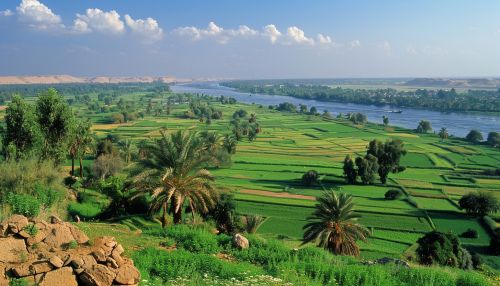Nile Valley
Geography and Environment
The Nile Valley is a region in northeastern Africa that encompasses the fertile land surrounding the Nile River, which is the longest river in the world. The valley extends from the river's sources in Burundi and Rwanda, through Uganda, South Sudan, Sudan, and Egypt, before emptying into the Mediterranean Sea. The Nile Valley is characterized by its narrow strip of arable land, which contrasts sharply with the surrounding deserts.


The valley's geography is defined by the river's annual flooding, which deposits nutrient-rich silt onto the surrounding land, making it highly fertile and suitable for agriculture. The climate of the Nile Valley varies from tropical in the south to arid in the north, with the region experiencing distinct wet and dry seasons.
Historical Significance
The Nile Valley has been a cradle of civilization for thousands of years. The ancient Egyptians, one of the earliest and most influential civilizations, thrived in this region due to the fertile land and reliable water supply provided by the Nile. The river was central to their agriculture, transportation, and trade, and it played a crucial role in the development of their society, culture, and economy.
The ancient Egyptian civilization is renowned for its monumental architecture, including the pyramids, temples, and tombs, which were constructed along the Nile. The river also facilitated the unification of Upper and Lower Egypt, leading to the establishment of a centralized state under the rule of the pharaohs.
Agriculture and Economy
Agriculture has been the backbone of the Nile Valley's economy for millennia. The annual inundation of the Nile provided a reliable source of water and fertile soil, allowing for the cultivation of crops such as wheat, barley, flax, and papyrus. The irrigation systems developed by the ancient Egyptians were sophisticated and allowed for the efficient management of water resources.
In modern times, the construction of the Aswan High Dam has significantly altered the hydrology of the Nile. While the dam has provided benefits such as hydroelectric power and improved flood control, it has also led to challenges such as reduced silt deposition and increased salinization of the soil.
Cultural and Religious Importance
The Nile River has held immense cultural and religious significance for the peoples of the Nile Valley. In ancient Egyptian religion, the Nile was personified as the god Hapi, who was believed to control the annual flooding. The river was also associated with the god Osiris, who was linked to fertility and the afterlife.
The Nile's importance extended beyond religion; it was a central element in the daily lives of the people. It provided water for drinking, bathing, and irrigation, and it was a vital transportation route that facilitated trade and communication.
Biodiversity
The Nile Valley is home to a diverse range of flora and fauna. The river and its surrounding wetlands support a variety of aquatic species, including fish, amphibians, and reptiles. The valley's fertile land also supports a range of terrestrial species, from mammals to birds.
The Nile crocodile is one of the most iconic species found in the river. Other notable species include the African elephant, hippopotamus, and various species of birds such as the African fish eagle and the sacred ibis.
Modern Challenges
The Nile Valley faces several modern challenges, including population growth, environmental degradation, and geopolitical tensions. The increasing demand for water resources has led to conflicts among the countries that share the Nile's waters. The construction of dams and other infrastructure projects has also had significant environmental impacts, affecting the river's flow and the ecosystems that depend on it.
Efforts to address these challenges include regional cooperation initiatives and sustainable development projects aimed at balancing the needs of human populations with the preservation of the Nile's natural resources.
